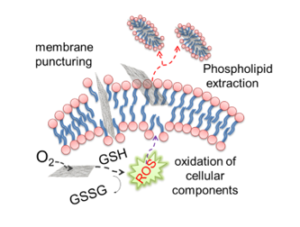The novel properties of nanomaterials can lead to new mechanisms of biological interactions. We aim to understand how nanomaterials interact with biological systems and to identify how changes in the physicochemical properties of nanomaterials can influence their cellular reactivity, intracellular fate, and potential toxicity. This fundamental understanding is then used to design safer nanomaterials or to tailor the unique biological interactions of nanomaterials for enhanced environmental, agricultural, or biomedical applications.

Mechanisms of interaction of graphene-based nanomaterials with biological membranes.
From Perreault et al. 2015. Chem. Soc. Rev. 44 (16), 5861-5896.
Selected Publications
Barrios, A.C., Cahue, Y.P., Wang, Y., Gilbertson, L., Puerari, R.C., Matias, W.G., Melegari, S.P., Perreault, F. 2021. Emerging Investigator Series: A multispecies analysis of the relationship between oxygen content and toxicity in graphene oxide. Environmental Science: Nano 8, 1543-1559.
Barrios, A.C., Wang, Y. Gilbertson, L., Perreault, F. 2019. Structure-property-toxicity relationships of graphene oxide: role of surface chemistry on the mechanisms of interaction with bacteria. Environmental Science and Technology 53, 14679-14687.
Bone, S., Alum, A., Markovski, J., Hristovski, K., Abbaszadegan, M., Kaufman, Y., Bar-Zeev, E., Perreault, F. 2018. Physisorption and chemisorption of T4 bacteriophages on amino functionalized silica particles. Journal of Colloid and Interface Science 532, 68-76.
Perreault, F., Faria, A.F., Nejati, S. Elimelech, M. 2015. Antimicrobial Properties of Graphene Oxide Nanosheets: Why Size Matters. ACS Nano 9, 7226-7236.
Funding sources
National Science Foundation (CBET-1708681)
National Science Foundation (CBET-2016501)

